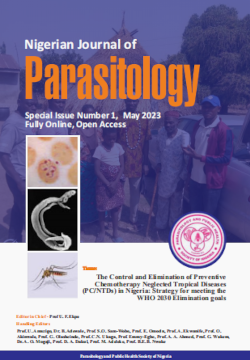Accessibility to Primary Health Center Facilities Using Geospatial Techniques In Southern Plateau, Nigeria
https://doi.org/10.4314/njpar.v41i2.3
Keywords:
Nigeria, Southern Plateau, PHC, Accessibility, Techniques, GeospatialAbstract
The Primary Health Center (PHC) System comprises of those small health care facilities which are based within communities
and are more accessible to people in need of healthcare. However, assessment of spatial patterns, distribution and provision
of public health services has been neglected. This research analyzes the availability and accessibility of Primary Health
Center (PHC) across Southern Plateau, Jos Plateau State. Spatial distribution of PHC was analyzed usingArcGIS to produce
accurate measure of accessibility. The spatial pattern of the PHC distribution was examined using average nearest neighbor
5km walking distance to providers (PHC) for each of the six LGAs using near analysis. In addition, the ratios of PHC to
population were calculated to identify underserved and served areas. The findings clearly indicate that the spatial pattern of
the distribution of PHC was significantly clustered in Quaan pan (62) [p-value 0.015305, Z-score 0.139526], Wase (38) [pvalue 0.046571, Z-score -1.990183] and Langtang South (34) [p-value > 0.096827, Z-score -1.660434], random in Mikang
(26) [p-value 0.889035 Z-score 0.139526] and Langtang North (52) [p-value 0.0883033, Z-score 0.147125) and dispersed in
Shendam (63) [p-value 0.072625, Z-score 1.795182]. PHC are dense within the central parts of each LGAs while low density
around the marginal parts. Substantially, more than half of the population 742,523 (62.74%) have no access to PHC within 5-
km distance and 441,063 (37.26%) of the population have access to PHC. More so, the population ratio to PHCs shows that 1
PHC served 3477 in Langtang North (least) and 1 to 5338 in Wase (highest). The output of this analysis which is spatial
distribution map and accessibility to this PHCs will assist policy-makers and authorities in planning public health delivery.
References
World Health Organization-United Nations Children Fund (WHO-UNICEF) (1978). Declaration of Alma Ata, 104pp.
Olise, P. (2007). Primary Health Care for Sustainable Development. Abuja: Ozege Publications, 24pp.
Samuel, K.J and Adagbasa, E. (2014). A Composed Index of Critical Accessibility (CICA) to healthcare services in a traditional
African City. GeoJournal, 79 (3), 267-278.
Lowe, J.C. and Moryades, S. (1975). The geography of movement Houghton muffin company boston, 23pp.
Chapman, K. (1979). People, pattern and process: An introduction to human geography 231pp.
Ingram, A.R. (1971). The concept of accessibility: a search for an operational form. Regional studies 5, 101 – 107.
Amer, S. (2007). Towards spatial justice in urban health services planning - a spatial analytic GIS based approach using Dar es Salaam, Tanzania as a case study, International Institute for GeoInformation Science and Earth, The Netherlands, 56pp.
Fletcher-Lartey, S.M. and Caprarelli, G. (2016). Application of GIS technology in public health: Successes and challenges. Parasitology, 143, 401–415.
Hanchette, C.L. Geographic Information Systems. In Public Health Informatics; O’Carroll, P.W., Yasnoff, Y.A., Ward, M.E., Ripp, L.H., Martin, E.L., Eds.; Springer: NewYork, NY, USA, (2003), 431–466.
Abdulraheem, I.S., Olapipo, A.R. and Amodu, M.O. (2012). Primary health care services in Nigeria: Critical issues and strategies for enhancing the use by the rural communities. Journal of Public Health and Epidemiology, 4(1), 5-13.
Nigerian Meteorological Agency. (2011). National Meteorological Office Weather Report 2010- 2015, Plateau State, Nigeria. Pp 2-7.
Getis, A. and Ord, J. K. (1998). Local spatial statistics: an overview in spatial analysis and modelling in a GIS environment, edited by
Longley, P. and Batty, M. John Wiley and Sons: NewYork, 223pp.
Michael, O. A. (2011). Towards Sustainable Distribution of Health Centers Using GIS: A Case Study of Lokoja from Nigeria. American Journal of Tropical Medicine and Public Health. 1(3), 130-136.
Mai Bukar, A. (2017). Geospatial Analysis of Healthcare Facilities in Maiduguri Local Government Area, Borno state, Nigeria. Unpublished dissertation submitted to the school of Post Graduate Studies Ahmadu Bello University Zaria, Nigeria, 91pp.
Umar, N. K. (2016). Analysis of Spatial Distribution of PHC Facilities in Kano South Senatorial District, Kano state, Nigeria. Unpublished dissertation submitted to the school of Post Graduate Studies Ahmadu Bello University Zaria, Nigeria, 89pp.
WHO, (2010). “Monitoring the Building Blocks of Health Systems: A Handbook of Indicators and Their Measurement Strategies.” Geneva, WHO. Accessed December 28, 2015. http://www.who.int/healthinfo/systems/WHO_MBHSS_2010_full_web.pdf
Downloads
Published
How to Cite
Issue
Section
License
Copyright (c) 2023 Nigerian Journal of Parasitology

This work is licensed under a Creative Commons Attribution-NonCommercial-NoDerivatives 4.0 International License.





